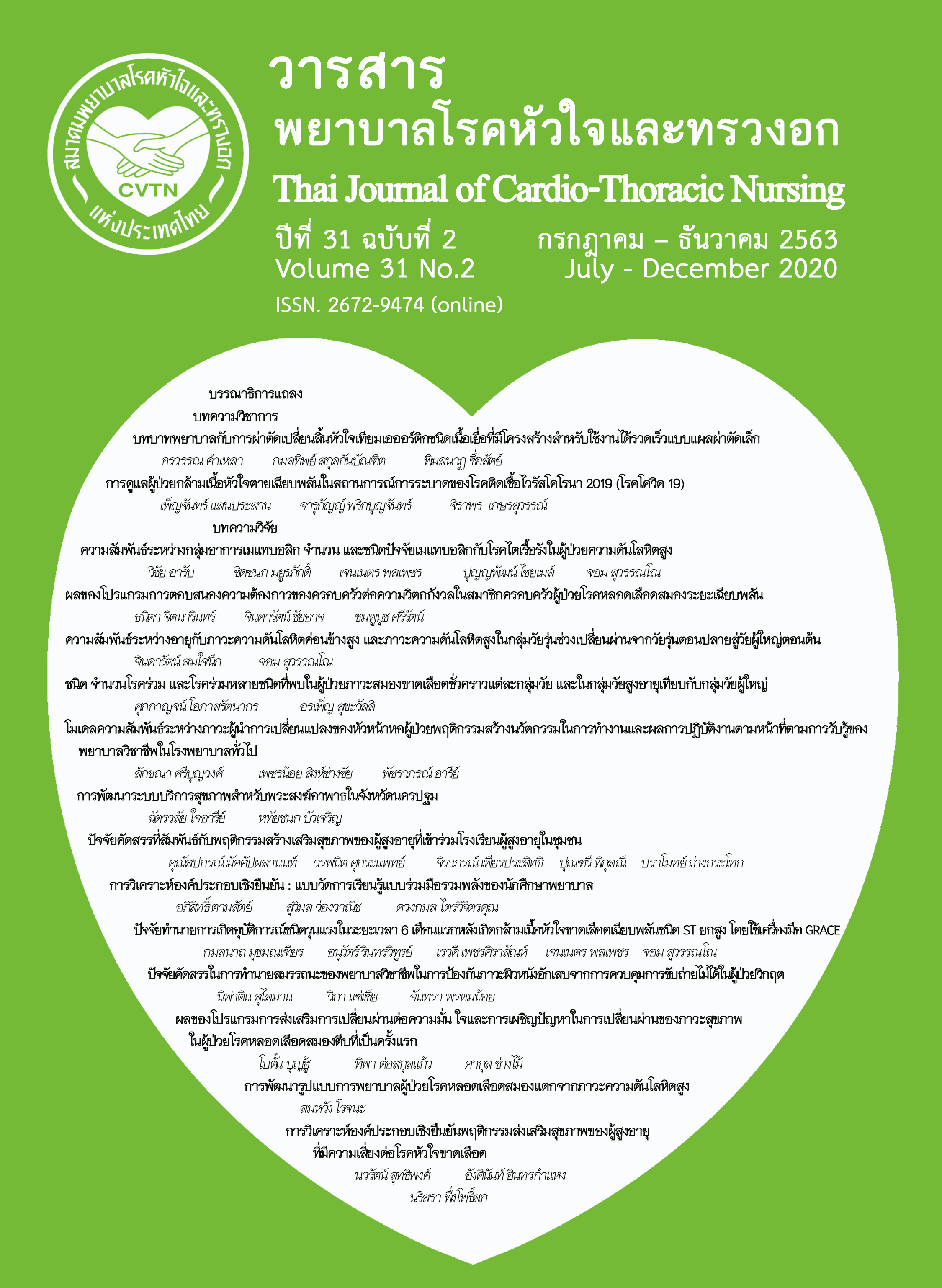Caring for acute myocardial infarction patients in the epidemic situation with Coronavirus Disease 2019 (COVID-19)
Keywords:
acute myocardial infarction, Coronavirus Disease 2019, nursing careAbstract
The epidemic situation of Coronavirus Disease 2019 (COVID-19) has transformed the world into a new era; that has altered the quality of life and trajectory of society around the world. The severity of the epidemic with Coronavirus Disease 2019 has resulted in high mortality of patients and affected the health of high-risk patients. Patients with acute myocardial infarction (MI) are high risk and has a life-threatened crisis if infected with COVID-19. Nurses’ role had to detect and assessment the patients with MI to access to emergency care. In addition, nurses have to inform the patients to reduce the spread of Coronavirus Disease 2019 and reduce risk factors after Acute Myocardial Infarction. Thus, the patients with acute myocardial infarction have a better quality of life when they have recovered and return home. They can perform self-care, health promotion and prevention risk factors of COVID-19 infection so that they could carry out activities of daily life appropriately and prevent the epidemic of COVID-19 in health care settings and communities.
References
Li Q, Guan X, Wu P, Wang X, Zhou L, Tong Y, et al. Early transmission dynamics in Wuhan, China, of Novel Coronavirus–infected pneumonia. N Engl J Med. 2020; 382 (13) :1199-207.
World Health Organization. WHO Coronavirus Disease (COVID-19) dashboard. Geneva: WHO; 2020.
Al Thobaity A, Alshammari F. Nurses on the frontline against the COVID-19 pandemic: an integrative review. Dubai Med J. 2020;3:87-92
Shi S, Qin M, Yang B. Coronavirus Disease 2019 (COVID-19) and cardiac injury—reply. JAMA Cardiology. 2020;5(10):1199-200.
Zhang H, Penninger JM, Li Y, Zhong N, Slutsky AS. Angiotensin-converting enzyme 2 (ACE2) as a SARS-CoV-2 receptor: molecular mechanisms and potential therapeutic target. Intensive Care Med. 2020;46(4):586-90.
Keresztes PA, Wcisel M. Management of clients with functional cardiac disorders. In: Black JM, Hawks JH, editors. Clinical management for positive outcomes. St Louis: Elsevier; 2009.
Walsh-Irwin C. Cardiovascular alterations. In: Black JM, Hawks JH, editors. Clinical management for positive outcomes. St Louis: Elsevier; 2013.
Tadiri CP, Gisinger T, Kautzy-Willer A, Kublickiene K, Herrero MT, Raparelli V, et al. The influence of sex and gender domains on COVID-19 cases and mortality. Can. Med. Assoc. J. 2020;192(36):E1041-E5.
Bruyninckx R, Aertgeerts B, Bruyninckx P, Buntinx F. Signs and symptoms in diagnosing acute myocardial infarction and acute coronary syndrome: a diagnostic meta-analysis. Br J Gen Pract. 2008;58(547):105-11.
Jeanagool P, Sabaisook S, Kongkaew S, Wimonsinrapin P, Luelarb P, Kramkeaw T, et al. Clinical performance and quality of care for patient with ST-elevation myocardial infarction at the Emergency Department in Central Chest Institute of Thailand. J Dept Med Ser. 2019;44(6):77-84.
Nielsen TJ, Vestergaard M, Christensen B, Christensen KS, Larsen KK. Mental health status and risk of new cardiovascular events or death in patients with myocardial infarction: a population-based cohort study. BMJ Open. 2013;3(8):e003045.
Januzzi JL, Lewandrowski K, MacGillivray TE, Newell JB, Kathiresan S, Servoss SJ, et al. A comparison of cardiac troponin T and creatine kinase-MB for patient evaluation after cardiac surgery. J Am Coll Cardiol 2002;39(9):1518-23.
Chan D, Ng LL. Biomarkers in acute myocardial infarction. BMC Med. 2010;8:34-.
The European Society for Cardiology. ESC guidance for the diagnosis and management of cv disease during the covid-19 pandemic. [document on the Internet]. [update 2020 June 10; cited 2020 June 14]. Available from: https://www.escardio.org/Education/COVID-19-and-Cardiology/ESC-COVID-19-Guidance.
The Criteria Committee of the New York Heart Association. Diseases of the Heart and Blood Vessels. Nomenclature and criteria for diagnosis of diseases of the heart and great vessels. 9th ed. Boston, MA: Lippincott Williams and Wilkins; 1994.
Lee C-K, Meng S-W, Lee M-H, Chen H-C, Wang C-L, Wang H-N, et al. The impact of door-to-electrocardiogram time on door-to-balloon time after achieving the guideline-recommended target rate. PLoS One 2019; 14(9): e0222019-e.
Forselv GC, Vik-Mo H. Acute coronary syndrome-ECG-changes without ST-elevation. Tidsskr Nor Laegeforen. 2007;127(17):2230-2.
Shub C. Echocardiography or auscultation? How to evaluate systolic murmurs. Can Fam Physician 2003;49: 163-7.
Christenson E, Christenson RH. The role of cardiac biomarkers in the diagnosis and management of patients presenting with suspected acute coronary syndrome. Ann Lab Med. 2013;33(5):309-18.
Shi S, Qin M, Shen B, Cai Y, Liu T, Yang F, et al. Association of cardiac injury with mortality in hospitalized patients with COVID-19 in Wuhan, China. JAMA Cardiology. 2020;5(7):802-10.
Department of Disease Control. Handbook of relief measures for business and activities to prevent the spread of COVID-19 spread [document on the Internet]. [update 2020 July 1; cited 2020 July 14]. Available from: https://ddc.moph.go.th/viralpneumonia/gui_covid19_phase.php.
Downloads
Published
How to Cite
Issue
Section
License
บทความนี้ยังไม่เคยตีพิมพ์หรืออยู่ในระหว่างส่งไปตีพิมพ์ในวารสารอื่น ๆ มาก่อน และกองบรรณาธิการขอสงวนสิทธิ์ในการตรวจทาน และแก้ไขต้นฉบับตามเกณฑ์ของวารสาร ในกรณีที่เรื่องของท่านได้ได้รับการตีพิมพ์ในวารสารฉบับนี้ถือว่าเป็น ลิขสิทธิ์ของวารสารพยาบาลโรคหัวใจและทรวงอก






